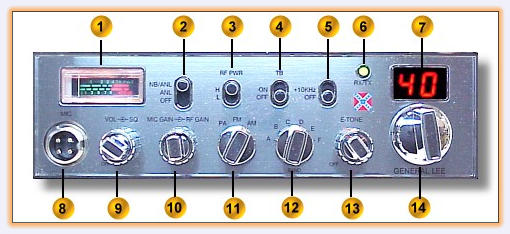

Review Of The General Lee 10 Meter Transceiver
The General Lee is an AM/FM 6-band 10 Meter radio. It is very similar to the Connex 3300HP, which has
been around for many years. Both of these radios are made by one of the RCI factories. A great deal of
thought went into making this an operator friendly radio. Some things have been added that radio operators
had their technicians install in the past on other similar rigs.
From first look, the radio looks like a Connex 3300 with its brushed aluminum front panel and chrome-
plated bezel. The Confederate flag type symbol does point out the difference though. Although it’s not a
politically correct radio, it is one of the hottest selling 10-meter radios today. Could it be it’s political
incorrectness or is it truly better than the competition? This is the object of the review.
A feature many truck drivers’ have considered in the last few years is the front mounted microphone
connector. With the size of the cubbyholes in the newer trucks getting smaller, it’s more difficult to mount a
radio with a side mounted microphone jack. The newer cars have become a greater challenge with their
less roomy interiors. With the mic connector coming out of the front, this means less width required for the
radio. In addition, the microphone cord won’t be bent at a right angle stressing the connections.

1.
1.S/RF Meter
2.
2.NB/ANL Switch
3.
3.HI/LO RF Output Power
4.
4.ON/OFF Talkback Switch
5.
5.+10 KHz Switch
6.
6.TX/RX LED
7.
7.LED Channel Readout
8.
Front Mounted 4-Pin Mic Wiring
9.
Volume/Squelch Control
10.
Mic Gain/RF Gain Control
11.
PA/AM/FM Mode Switch
12.
Band Selection Switch
13.
Echo ON/OFF/Delay/Volume Control
14.
Channel Selector Switch
There is the addition of a talkback switch allowing the talkback to be turned on or off independent of the
echo. In many radios of this design, the talkback automatically turns on with the echo. If a noise-canceling
mic wasn’t used or if a speech processor is used, the mic gain may have to be lowered to keep the
talkback from going into feedback. Lowering the mic gain to satisfy the needs of the talkback circuit usually
creates an under modulated signal. With the talkback switch, the echo can be set at a lower modulation
level and once the talkback is turned off, the modulation can be set to a proper level and all is well. Of
course, if you want talkback all the time, a RK-56 mic will do the trick or a UTB-1 adjustable talkback kit
could be installed.
The other notable change is in the band selection. The Connex has a 3-position switch in conjunction with
a high low switch. If that isn’t complicated enough, the switch is marked A/D for position 1, B/E for position
2, and C/F for position 3. This system took two control positions on the radio face as well as making the
radio more difficult to use. The General Lee has a 6-position switch marked A-F for its band selection.
The remaining features are the same as the Connex 3300. The automatic noise limiter (ANL) works very
well on all types of noise in the audio detection, and the noise blanker (NB) does its job removing additional
interference at the RF level. If all is electrically quiet, the ANL & NB can be turned off for increased audio
quality.
The RF output power is switchable from high to low. Both the high and low settings have adjustment
potentiometers to preset to your desired carrier settings. This is convenient if an external amplifier is used.
Different amps require various drive levels to perform properly. The low power can be set for the optimum
AM carrier level and the high setting can be set for the optimum FM setting. Or if you don’t intend on using
FM as do most operators, the high setting can be set to optimum high power carrier to modulation swing.
Next is the +10 KHz switch. Many radio operators don’t understand the purpose of the +10 KHz switch.
This switch increases the frequency by 10 KHz or 1 channel. If the radio was on channel one and the +10
KHz switch was turned on, the radio would then be on channel 2. You might ask what useful purpose does
that serve. Well, these chassis are nothing more than converted CB chassis using the same switches used
in CB radios. The switches have channel skips built in for the radio control (RC) channels used for remote
control devices. These RC channels are also referred to as “A” channels. There are RC channels between
channels 3 & 4, 7 & 8, 11 & 12, 15 & 16, and 19 & 20. Some radios designate them as 3A, 7A, 11A, 15A,
and 19A. Being a function of the channel selector switch, this means these skips occur on all six bands
making a grand total of 30 skipped channels or frequencies. To pick up one of these skips, go to 3, 7, 11,
15, or 19 and turn on the +10 KHz switch and you’re there.
Receiver audio volume is very good. The volume can be turned up quite a bit before the distortion level is
noticeable. With a good quality external speaker such as the PDC-101 or the Texas Ranger SRA-168
series speakers, the audio is much louder and cleaner. This isn’t surprising, most CB and 10-meter radios
don’t have very high quality sounding internal speakers. The exceptions to this rule are the Ranger AR-
3300 & 3500, Magnum Alpha & Delta Force radios. The squelch range is very good and has an internal
coarse adjustment. Adjusting the internal coarse control will increase or decrease the maximum signal level
needed to break through the squelch at its maximum setting. Increasing it requires a stronger signal to
override the squelch, but this makes the front panel adjustment more critical to adjust. Decreasing the
coarse adjustment allows weaker signals to break through the squelch on the maximum front panel control
setting and makes the squelch control finer or less critical to adjust.
The RF gain control is typical of radios in this league; most of the adjustment is in a small area of rotation in
this control. This is also true in Connex, Galaxy, Super Star, Magnum and many other radios. The front-end
of these radio designs use a similar scheme in reducing the receiver sensitivity. The mic gain has a
complete control from no audio to full audio output. The gain of this radio is sufficient to use a RK-56B with
it, but the Astatic 636L sounds a little low without making modifications to the microphone preamp stage in
the radio or adding a speech processor.
Some operators don’t like the new type echo board in this and the Connex 3300 radios. This new design
incorporates a digital echo chip that produces very clean reverb and repeat echo. Opponents to this new
design can’t describe what they don’t like about it, but in my opinion, it’s ten times better than the earlier
version of echo board. It’s quite easy to adjust to the desired effect.
The output power is very good. Some dealer set the AM carrier to 15 watts, but I prefer to set it to 10 and
have the modulation swing to 38 to 40 watts. The modulation can be adjusted to swing above 30 watts by
adjusting the AMC control, removing the limiter completely will give a higher swing, of course the
modulation will be clipping considerable. Even with this clipping, the audio will sound much better than
adding one of those super mod kits.
The receiver sensitivity is very good and can be increased by tuning it to 11-meters. The selectivity is
excellent even after tuning for increased sensitivity. I've found some radios detuned to mask selectivity
problems in the past, but the selectivity stayed the same form before and after.
I highly recommend this radio if you like the band selection method of uppers and lowers as well as only
needing AM/FM. It’s a good looking radio with better functionality than other radios in its price range. With
the additional features and lower price than the Connex 3300HP the choice is easy.
Bob F
General Lee Rear Panel


© CB World Informer Network 1996 - 2023 Worldwide Rights Reserved

October
2001Web
Edition


- August 1996
- September 1996
- October 1996
- November 1996
- December 1996
- Review Of Midland 79-290 AM/SSB Mobile
- Cobra/Uniden SSB Chassis Mod UPDATE
- Clarifiers
- President Jackson Unlocked Clarifier Mod.
- Cobra 148 & Uniden GrantXL Clarifier Mod.
- Cobra 142GTL & Uniden Washington Clarifier
- Uniden Grant Unlocked Clarifier Mod.
- Uniden PCI22 PRO SSB Clarifier Mod.
- Review Of The Northstar DX880HL
- Big Bust At The Consumer Electronics Show
- Bob's CB Has Opened
- January 1997
- The New Mongoose Model 450 Review
- Wilson Antenna Tests The Trucker 5000
- A Company With Interference Solutions
- Solving Telephone RF Interference
- Lowpass Filters: What, Where, And How
- Using Highpass Filters For TVI
- How To Conduct A Noise Audit
- Modern Do-It-Yourself Grounding Techniques
- Using Water Pipes For RF Grounding
- Using Water Pipes For RF Grounding
- February 1997
- The New Emperor TS-3010 Review
- Bulkhead Grounding
- Grounding Coaxial Cable Shields
- Using Anti-Oxidants
- Modern Lightning Protection - RF Entry Ports
- Modern Lightning Protection - AC Power Lines
- Modern Lightning Protection - Control Lines
- Modern Lightning Arrestors - Polyphaser VS I.C.E.
- Modern Lightning Arrestors - Alpha Delta VS I.C.E.
- Modern Lightning Arrestors - Cushcraft VS I.C.E.


- July 2001
- Galaxy DX 2547 Reveiw
- Inside The DX 2547
- DX 2547 Channel Mod
- DX 2547 Clarifier Mod
- DX 2547 Photos
- DX 2547 Manual Excerpts
- The Anttron Story
- Anttron 305 Revisited
- New Antrron Products
- Aries A-SWR 460 Digital Meter
- Barjan Buys Wilson Antenna
- Wilson Electronic In Cell Phone Market
- First Web Issue
- Help Get The Word Out
- August 2001
- Sneak Preview: The New Maverick A24
- Maverick A24 Front Panel Controls
- Maverick Conversion
- Inside The Magnum Maverick A24
- Barjan Buys Francis Antenna
- Wilson Antenna, 1 Year After Barjan Buyout
- CBer Busted
- Astaic's MobileMax
- Solarcon I-Max 2000
- False Performance Claims
- CAUTION: Don't Burn Out That Radio
- Magnum's Filtered Power Cord
- Dragon Super Heavy Duty SO-239 Stud
- CBWI...Give Us Your Opinion
- September 2001
- Reveiw Of The RCI 2950DX
- RCI 2950DX Image Rejection Modification
- RCI 2950DX Coversion & Clarifier Mods
- RCI 2950DX Photos
- RCI 2950DX Board Component Layout
- RCI 2950DX Adjustment Layout
- RM-9807: Petition To Remove 155 Mile Limit
- Slip-Seat Radio Box
- RF Limited UTB-1 Adjustable Talkback Board
- A Message From The Editor
- October 2001
- November 2001
- December 2001
- January 2002
- February 2002
- July 2002
- June 2014





























